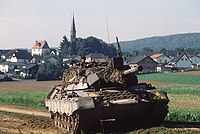GBT-65 Lav
This article is incomplete because it is pending further input from participants, or it is a work-in-progress by one author. Please comment on this article's talk page to share your input, comments and questions. Note: To contribute to this article, you may need to seek help from the author(s) of this page. |
| GBT-65 Lav/Lew ГБТ-65 Лав | |
|---|---|
 GBT-65 Lav on a parade in Katowice | |
| Type | Main battle tank |
| Place of origin | |
| Service history | |
| In service | 1965-2001 |
| Used by | |
| Production history | |
| Manufacturer | |
| No. built | ~2,000 |
| Variants | See GBT-65 Lav#Variants |
| Specifications | |
| Weight | 42.2 tons |
| Length | 9.54 meters |
| Width | 3.37 meters |
| Height | 2.37 meters |
| Crew | 4 |
Main armament | 1x 105mm DT105 or 120mm DT120 (13 rounds in turret 42 rounds in hull) |
Secondary armament | 2x 7.62 KMT Machine Gun |
| Engine | FMK 1435 10-cylinder, 37.4 litres, multi-fuel engine 850 horsepowers |
| Power/weight | 19.6 PS (14.5 kW) /tonne |
| Suspension | Torsion bar |
Operational range | 600 km (on road), 450 km (cross-country) |
| Speed | 65km/h |
GBT-65 Lav (Serbian: ГБТ-65 Лав; Mazurian: CzP-65 Lew) (or Lav (Meaning lion in Serbian)) was main battle tank built and used by Nikolia in period between 1965 to 2001.
Design and development
In mid 1950's, development of tanks in the rest of Astyria brought the current Nikolian armour to weak position. This led to initiating "Projekt 60" in which a new main battle tank platform was going to be developed. Several main goals were given to the VTI by the army experts; the new tank should not be heavier than 30 tonnes, the armour should withstand fire from 20mm autocannon on all sides, the tank should be operable on field contaminated with chemicals or radiation and the tank should be mobile on cross-country terrain. With development of HEAT ammunition, a concept of heavily armoured tank was quickly scrapped, and firepower and mobility were the main goals of development team of VTI. The first prototype Projekt 60 was tested in 1960. Completely new chassis was developed, however a turret from earlier N-45, albeit modified to host the new DT105 105mm gun, was used. The initial tests showed many faults in the design. Firstly, position of radiators on the rear sides made them extremely vulnerable even to small arms fire, the optics were obsolete and there was room only for 24 rounds of ammunition. Development team went back to the drawing board, and in 1962 the second prototype named Projekt 62 Lav was sent to tests. Compared to its earlier version, Projekt 62 had new cast turret with two bumps on each side to house the new optics for triangulation. The turret was also a bit taller because it was decided that newly designed optical range-finding system shall be put. The engine compartment was raised, and the radiators were placed above the engine. With moving the engine compartment, the room was made for additional rounds, boosting the total number of rounds to 42 in the hull and 13 in the turret. The Projekt 62 was approved by the army experts and it entered the mass production in 1965 named GBT-65 Lav. The first batch nearly immediately saw combat as Nikolia got involved in Caranad Conflict.
Versions
GBT-65A
Following the experiences from the Caranad Conflict, the VTI made several changes to the original model. New gun stabilisation system was installed, which allowed the cannon to fire effectively on the move. Also, a thermal jacket was added to the gun to control heating during the long intervals of firing. Protective skirts were added to protect the upper tracks, and the tracks itself got rubber pads which can easily be changed to "X" pads for better traction on snow and ice.
GBT-65A1
GBT-65A1 is further development of GBT-65A. It received additional armour plates on the turret as well as image intensifier night sights mounted in a box on the upper right side of the gun.
GBT-65B
In early 1970's GBT-65 received a new update - the GBT-65B. The new version had new welded turret which was equipped with a new armour consisting of two spaced steel plates with a plastic filling between them (high-hardness armor), and a wedge-shaped gun mantlet. The internal volume was increased by 1.2 m³ and the effective level of protection was increased by half. In addition to the new turret, new independent sight was installed for the commander, and digital radios were also fitted.
GBT-65M1
Parallel to the development of its successor, GBT-85, GBT-65 was a testing platform for newest systems and technology before fitting it to GBT-85. In 1980, GBT-65M1 was developed, encompassing several new systems. Although externally there were no major changes, various new electronic systems were installed inside. The first major upgrade was UKV-300 computerised fire control system and the new sighting system to aim it. In addition to that, commander independent sight was upgraded to allow night sighting.


